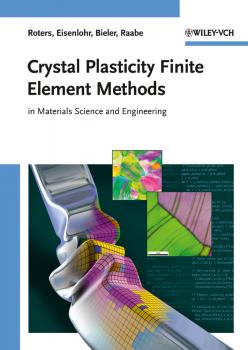Техническая литература
Различные книги в жанре Техническая литератураInternational Smelting Technology Symposium. Incorporating the 6th Advances in Sulfide Smelting Symposium
Proceedings of a symposium sponsored by The Metallurgy and Materials Society of CIM and the Pyrometallurgy Committee of the Extraction and Processing Division of TMS (The Minerals, Metals & Materials Society) Held during the TMS 2012 Annual Meeting & Exhibition Orlando, Florida, USA, March 11-15, 2012
Crystal Plasticity Finite Element Methods. in Materials Science and Engineering
Written by the leading experts in computational materials science, this handy reference concisely reviews the most important aspects of plasticity modeling: constitutive laws, phase transformations, texture methods, continuum approaches and damage mechanisms. As a result, it provides the knowledge needed to avoid failures in critical systems udner mechanical load. With its various application examples to micro- and macrostructure mechanics, this is an invaluable resource for mechanical engineers as well as for researchers wanting to improve on this method and extend its outreach.
Optical and Digital Image Processing. Fundamentals and Applications
In recent years, Moore's law has fostered the steady growth of the field of digital image processing, though the computational complexity remains a problem for most of the digital image processing applications. In parallel, the research domain of optical image processing has matured, potentially bypassing the problems digital approaches were suffering and bringing new applications. The advancement of technology calls for applications and knowledge at the intersection of both areas but there is a clear knowledge gap between the digital signal processing and the optical processing communities. This book covers the fundamental basis of the optical and image processing techniques by integrating contributions from both optical and digital research communities to solve current application bottlenecks, and give rise to new applications and solutions. Besides focusing on joint research, it also aims at disseminating the knowledge existing in both domains. Applications covered include image restoration, medical imaging, surveillance, holography, etc… «a very good book that deserves to be on the bookshelf of a serious student or scientist working in these areas.» Source: Optics and Photonics News
Complex Metallic Alloys. Fundamentals and Applications
Covering fundamental research as well as real-world applications, this first book on CMAs at an introductory level treats everything from atomistic details to surface processing. Comprehensive, self-contained chapters provide readers with the latest knowledge on the most salient features of the topic, selected in terms of their relevance to potential technological applications. Edited by one of the most distinguished authorities on quasicrystals and this most important of their subclasses, the contributions elucidate aspects of CMAs from a particular viewpoint: physical and chemical characteristics in the sub-nanometer regime, mesoscale phenomena, preparation and processing of thin films, and large-scale engineering properties. The whole is rounded off by a look at the commercial potential of CMA-based applications. For PhD students and lecturers alike.
Color in Computer Vision. Fundamentals and Applications
While the field of computer vision drives many of today’s digital technologies and communication networks, the topic of color has emerged only recently in most computer vision applications. One of the most extensive works to date on color in computer vision, this book provides a complete set of tools for working with color in the field of image understanding. Based on the authors’ intense collaboration for more than a decade and drawing on the latest thinking in the field of computer science, the book integrates topics from color science and computer vision, clearly linking theories, techniques, machine learning, and applications. The fundamental basics, sample applications, and downloadable versions of the software and data sets are also included. Clear, thorough, and practical, Color in Computer Vision explains: Computer vision, including color-driven algorithms and quantitative results of various state-of-the-art methods Color science topics such as color systems, color reflection mechanisms, color invariance, and color constancy Digital image processing, including edge detection, feature extraction, image segmentation, and image transformations Signal processing techniques for the development of both image processing and machine learning Robotics and artificial intelligence, including such topics as supervised learning and classifiers for object and scene categorization Researchers and professionals in computer science, computer vision, color science, electrical engineering, and signal processing will learn how to implement color in computer vision applications and gain insight into future developments in this dynamic and expanding field.
Performance Based Building Design 2. From Timber-framed Construction to Partition Walls
Just like building physics, performance based building design was hardly an issue before the energy crises of the 1970ies. With the need to upgrade energy efficiency, the interest in overall building performance grew. The term «performance» encompasses all building-related physical properties and qualities that are predictable during the design stage and controllable during and after construction. The term «predictable» demands calculation tools and physical models that allow evaluating a design, whereas «controllable» presumes the existence of measuring methods available on site. The basis for a system of performance arrays are the functional demands, the needs for accessibility, safety, well-being, durability, energy efficiency and sustainability and the requirements imposed by the usage of a building. In continuation of Vol. 1 this second volume discusses light-weight construction with wooden and metal elements, roofing systems, facades, and ends with finishes and the overall risk analysis. Most chapters build on a same scheme: overview, overall performance evaluation, design and construction. The work is absolutely recommended to undergraduates and graduates in architectural and building engineering, though also building engineers, who want to refresh their knowledge, may benefit. The level of discussion assumes the reader has a sound knowledge of building physics, along with a background in structural engineering, building materials and building construction. Where and when needed, input and literature from over the world was used, reason why each chapter ends listing references and literature.
60GHz Technology for Gbps WLAN and WPAN. From Theory to Practice
This book addresses 60 GHz technology for Gbps WLAN and WPAN from theory to practice, covering key aspects for successful deployment. In this book, the authors focus specifically on 60 GHz wireless technology which has emerged as the most promising candidate for multi-gigabit wireless indoor communication systems. 60 GHz technology offers various advantages over current or existing communications systems (e.g. huge unlicensed bandwidth worldwide, high transmit power, high frequency reuse and small form factor), which enables many disruptive applications that are otherwise difficult if not impossible to be realized at lower frequencies. The book addresses all aspects of the state-of-the-art in 60 GHz technology for high data rate wireless applications. Key Features: Comprehensive coverage from theory to practice: provides readers with a thorough technical guide of 60 GHz technology development Brings together the entire area of 60GHz technology for Gigabits per second (Gbps) WLAN and WPAN applications. Discusses practical system designs covering wide aspects such as antenna propagation, beamforming, circuit design, digital communication, signal processing, system architectures, etc. Provides up-to-date standardization activities, regulatory issues, technology development as well as future trends Includes examples and case studies for practical scenarios Contains theoretical, simulation and experimental results to demonstrate and compare the performance of various schemes (or systems) This book serves as an excellent reference for system engineers, system architects, IC designers, standard engineers, researchers, and vendor and manufacturer consumers. Technical consultants, software and application developers will also find this book of interest.
Modelling and Dimensioning of Mobile Wireless Networks. From GSM to LTE
This book is a must-read for all network planners and other professionals wishing to improve the quality and cost efficiency of 3G and LTE networks In this book, the authors address the architecture of the 2/3G network and the Long Term Evolution (LTE) network. The book proposes analytical models that make the analysis and dimensioning of the most important interfaces, i.e. WCDMA or Iub, possible. Furthermore, the authors include descriptions of fundamental technological issues in 2/3 G networks, basic traffic engineering models and frequent examples of the application of analytical models in the analysis and dimensioning of the interface of cellular networks. The specific knowledge included in the content will enable the reader to understand and then to prepare appropriate programming softwares that will allow them to evaluate quality parameters of cellular networks, i.e. blocking probabilities or call losses. Additionally, the book presents models for the analysis and dimensioning of the Wideband Code Division Multiple Access (WCDMA) radio interface and the Iub interface, both carrying a mixture of Release 99 traffic (R99) and High-Speed Packet Access (HSPA) traffic streams. Finally, the analytical models presented in the book can be also used in the process of modeling and optimization of LTE networks. Key Features: Describes the architecture and the modes of operation of the cellular 2/3/4G systems and the LTE network Covers the traffic theory and engineering within the context of mobile networks Presents original analytical methods that enable their users to dimension selected interfaces of cellular networks Discusses models for the analysis and dimensioning of the Wideband Code Division Multiple Access (WCDMA) radio interface and the Iub interface, both carrying a mixture of Release 99 traffic (R99) and High-Speed Packet Access (HSPA) traffic streams Includes problems as well as an accompanying website containing solutions, software tools and interactive flash animations (http://wiley.teletraffic.pl) This book will be an invaluable guide for professional engineers (radio planning engineers, optimization engineers, transmission engineers, core network engineers, Service Management engineers) working in the areas of mobile wireless networks technology, not only in optimization process, but also in profitability assessment of newly implemented services (i.e. in NPV – Net Present Value analysis), and researchers and scientists. Advanced students in the fields of mobile communications networks and systems will also find this book insightful.
Product Design and Engineering. Formulation of Gels and Pastes
Covering the whole value chain – from product requirements and properties via process technologies and equipment to real-world applications – this reference represents a comprehensive overview of the topic. The editors and majority of the authors are members of the European Federation of Chemical Engineering, with backgrounds from academia as well as industry. Therefore, this multifaceted area is highlighted from different angles: essential physico-chemical background, latest measurement and prediction techniques, and numerous applications from cosmetic up to food industry. Recommended reading for process, pharma and chemical engineers, chemists in industry, and those working in the pharmaceutical, food, cosmetics, dyes and pigments industries.
Terpyridine-based Materials. For Catalytic, Optoelectronic and Life Science Applications
In recent years, the utilization of terpyridines both in macromolecular structure assembly and device chemistry has exploded, enabling, for example, supramolecular polymer architectures with switchable chemical and physical properties as well as novel functional materials for optoelectronic applications such as light-emitting diodes and solar cells. Further applications include the usage of terpyridines and their metal complexes as catalysts for asymmetric organic reactions and, in a biological context, as anti-tumor agents or biolabels. This book covers terpyridine-based materials topics ranging from syntheses, chemistry, and multinuclear metal complexes, right up to functionalized polymers, 3D-architectures, and surfaces. Aimed at materials scientists, (in)organic chemists, polymer chemists, complex chemists, physical chemists, biochemists, and libraries.









